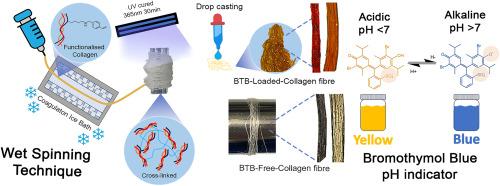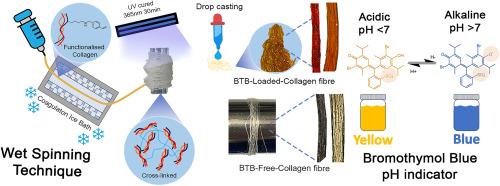An infection-responsive collagen-based wet-spun textile fibre for wound monitoring
IF 4.5
2区 化学
Q2 POLYMER SCIENCE
引用次数: 0
Abstract
Wound infections are a significant clinical and socioeconomic challenge, contributing to delayed healing and increased wound chronicity. To enable early infection detection and inform therapeutic decisions, this study investigated the design of pH-responsive collagen fibres using a scalable wet spinning process, evaluating product suitability for textile dressings and resorbable sutures. Type I collagen was chemically functionalised with 4-vinylbenzyl chloride, enabling UV-induced crosslinking and yielding mechanically robust fibres. Bromothymol blue, a halochromic dye responsive to pH changes, was incorporated via drop-casting to impart visual infection-responsive colour change. Gravimetric analysis and Fourier Transform Infrared Spectroscopy confirmed high dye loading, whereby a Loading Efficiency of 99 ± 3 wt% was achieved. The fibres exhibited controlled swelling in aqueous environments (Swelling Ratio: 323 ± 79–492 ± 73 wt%) and remarkable wet-state Ultimate Tensile Strength (UTS: 12±3–15 ± 7 MPa), while up to ca. 30 wt% of their initial crosslinked mass was retained after 24 h in a collagenase-rich buffer (pH 7.4, 37 °C, 2 CDU) and ethanol series dehydration. Importantly, distinct and reversible colour transitions were observed between acidic (pH 5) and alkaline (pH 8) environments, with up to 88 wt% dye retention following 72-h incubation. The fibres were successfully processed into woven dressing prototypes and demonstrated knotting ability suitable for suture applications. Overall, these wet-spun collagen fibres integrate infection-responsive capability, biodegradability, and scalable fabrication, representing a promising platform for smart wound dressings and resorbable sutures.


一种用于伤口监测的感染反应性胶原基湿纺纺织纤维
伤口感染是重大的临床和社会经济挑战,有助于延迟愈合和增加伤口慢性。为了能够早期发现感染并为治疗决策提供信息,本研究使用可扩展的湿纺丝工艺研究了ph反应性胶原纤维的设计,评估了产品用于纺织敷料和可吸收缝合线的适用性。I型胶原蛋白用4-乙烯基苄基氯化学功能化,使紫外线诱导交联,产生机械坚固的纤维。溴百里酚蓝是一种对pH值变化有反应的变色染料,通过滴注加入,赋予视觉感染反应性颜色变化。重量分析和傅里叶变换红外光谱证实了高染料负载,因此负载效率达到99±3 wt.%。纤维在水环境中表现出可控的膨胀(膨胀率:323±79-492±73 wt.%)和显著的湿态极限拉伸强度(UTS: 12±3-15±7 MPa),而在富含胶原酶的缓冲液(pH 7.4, 37°C, 2 CDU)和乙醇系列脱水24小时后,其初始交联质量保留了约30 wt.%。重要的是,在酸性(pH 5)和碱性(pH 8)环境之间观察到明显和可逆的颜色转变,在72小时的孵育后,染料保留率高达88 wt.%。纤维成功地加工成编织敷料原型,并证明了适合缝合应用的打结能力。总的来说,这些湿纺胶原纤维具有感染反应能力、生物降解性和可扩展性,代表了智能伤口敷料和可吸收缝合线的一个有前途的平台。
本文章由计算机程序翻译,如有差异,请以英文原文为准。
求助全文
约1分钟内获得全文
求助全文
来源期刊

Polymer
化学-高分子科学
CiteScore
7.90
自引率
8.70%
发文量
959
审稿时长
32 days
期刊介绍:
Polymer is an interdisciplinary journal dedicated to publishing innovative and significant advances in Polymer Physics, Chemistry and Technology. We welcome submissions on polymer hybrids, nanocomposites, characterisation and self-assembly. Polymer also publishes work on the technological application of polymers in energy and optoelectronics.
The main scope is covered but not limited to the following core areas:
Polymer Materials
Nanocomposites and hybrid nanomaterials
Polymer blends, films, fibres, networks and porous materials
Physical Characterization
Characterisation, modelling and simulation* of molecular and materials properties in bulk, solution, and thin films
Polymer Engineering
Advanced multiscale processing methods
Polymer Synthesis, Modification and Self-assembly
Including designer polymer architectures, mechanisms and kinetics, and supramolecular polymerization
Technological Applications
Polymers for energy generation and storage
Polymer membranes for separation technology
Polymers for opto- and microelectronics.
 求助内容:
求助内容: 应助结果提醒方式:
应助结果提醒方式:


